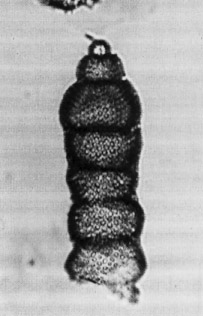 Stichocorys
delmontensis (Campbell and Clark)
Stichocorys
delmontensis (Campbell and Clark) Stichocorys
delmontensis (Campbell and Clark)
Stichocorys
delmontensis (Campbell and Clark)Eucyrtidium delmontense Campbell and Clark, 1944, p.56, pl.7, figs.19-20
Stichocorys delmontensis (Campbell and Clark) Sanfilippo and Riedel, 1970, p.451, pl.1, fig.9 (with synonymy)
Shell not especially large, rather stout (1.6-2.4 diameters of cylinder in length); cephalis knoblike, distinct, with much lateral flattening, and with a short, sometimes curved, or straight, apical horn, cervix truncate and constricted; thorax distinct, truncate apically, subhemispherical, its basal diameter exceeding distal diameter, and marked by an internal transverse septum; abdominal joints three, clearly limited by lumbar constrictions and transverse septa, uppermost joint subhemispherical like thorax and more or less continued in contour with it, these two regions forming, as a whole, a cone (45°), its sides strongly bulged, its length ~0.29 total length, and its basal diameter 1.37 upper diameters, second and third joints together subcylindrical, second one about same length as first, and third one shorter, its distal end inturned with a somewhat constricted mouth with short, projecting, discrete, spinelike denticles (mouth commonly torn); wall uniformly thin, gray; pores lacking on cephalis, on thorax ~40, well scattered, in subhexagonal areas with raised corners, pores of abdomen larger than those of thorax, well-separated, scattered, all pores subcircular (Campbell and Clark, 1944).
The upper conical, generally more robust part of the shell is formed of three segments. Thorax generally has more pores than in S. wolffii, and the fourth segment lacks longitudinal ribs. Third segment inflated annular, rather than truncate conical as in its direct evolutionary descendant, S. peregrina (Riedel and Sanfilippo, 1978a).
The third segment is typically inflated annular, but specimens with conical third segments are admitted here if the fourth segment is not as wide as the third (Westberg and Riedel, 1978).
Stichocorys peregrina has the upper, conical part of the shell composed of four segments rather than three, the third segment typically truncate-conical rather than annular, and the fourth segment as wide as or wider than the third. S. wolffii has fewer pores on the thorax, and longitudinal ridges on the fourth segment of some specimens. There is an undescribed Eocene form, probably related to Eucyrtidium montiparum Ehrenberg (1873, p.230; 1875, pl.9, fig.11), in which the thorax is slightly more conical than that of Stichocorys delmontensis, but which is so similar that the species are difficult to distinguish unless age is taken into account (Sanfilippo et al., 1985).
The proximal conical part of the shell, formed of three segments, is generally more robust than the distal segments. The fourth segment (in some specimens as robust as the third) is narrower than the third. Thorax and subsequent segments are generally evenly perforate, with circular to subcircular pores. Total number of segments varies from four to about nine. Late specimens are commonly larger (length of first three segments (excluding horn) 105-120 µm; maximum breadth of third 85-100 µm) than earlier ones (length of first three segments 95-105 µm; maximum breadth of third 80-90 µm). In some middle-latitude assemblages, specimens almost certainly belonging to this species have the fourth and subsequent segments as wide as the third, and therefore cannot be recognized individually (Sanfilippo et al., 1985).
Stichocorys delmontensis is widespread and common in assemblages of middle early to late Miocene age in low and middle latitudes. Its morphotypic first appearance lies within the Stichocorys delmontensis Zone. Its evolutionary transition to Stichocorys peregrina defines the base of the Stichocorys peregrina Zone.
This species apparently arose from a robust many-segmented form with no distinction between an upper conical part of the shell and a lower cylindrical one, which is common in early Miocene assemblages but not yet described. It evolved into S. peregrina.
Additional illustrations can be found in Sanfilippo et al., 1973, pl.6, fig.3; Westberg and Riedel, 1978, pl.3, figs.1-5.
Reynolds (1980) defines the base of his Theocorys redondoensis Zone in the western North Pacific by the evolutionary transition from S. delmontensis to S. peregrina. The S. peregrina Zone of Riedel and Sanfilippo (1978a) is partially equivalent to this zone.